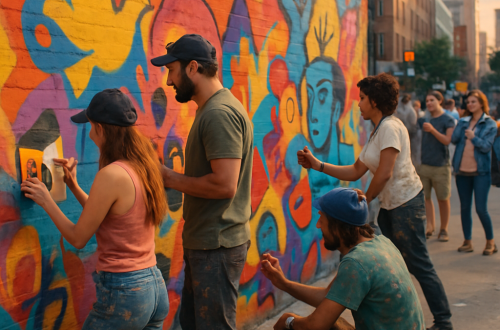Digital Art and Cultural Identity: How Technology is Redefining Artistic Expression
In the realm of art and culture, the digital revolution has introduced a profound transformation, redefining the boundaries and expressions of artistic creation. The advent of digital technology not only expands the tools available to artists but also reshapes the very notion of cultural identity in art. As artists incorporate digital technology into their creative processes, they navigate a new landscape that blends traditional cultural expressions with modern digital forms. This intersection of digital art and cultural identity offers a unique lens through which to view the evolving role of technology in artistic expression.
The Rise of Digital Art
Digital art, a term that encompasses works created using digital technology, has emerged over the last few decades as a significant genre in the art world. From digital painting and sculpture to interactive installations and virtual reality, the scope of digital art is vast and varied. This form of art utilizes software, algorithms, and digital interfaces to create works that can either stand alone or complement traditional techniques.
The proliferation of digital tools has democratized the art creation process, providing artists from diverse backgrounds with the means to express their cultural narratives. With tools such as graphic tablets, 3D modeling software, and digital canvases, artists are no longer bound by the physical limitations of traditional media.
Cultural Identity in the Digital Realm
Cultural identity plays a pivotal role in shaping the themes and aesthetics of an artist’s work. In traditional art forms, cultural elements are often conveyed through specific styles, symbols, or materials unique to a region or community. Digital art, by contrast, often transcends geographical and physical boundaries, creating a new space for cultural expression that is both global and local.
For many digital artists, technology is a way to explore and reaffirm their cultural heritage in a modern context. By integrating traditional motifs and stories into digital formats, artists can preserve and perpetuate their cultures while also making them accessible to a broader audience. This fusion of the old and the new not only enriches the art itself but also invites viewers to engage with cultural narratives in innovative ways.
Case Studies: Digital Artists and Cultural Expression
To better understand how digital art influences cultural identity, consider the work of several prominent artists who incorporate their heritage into their digital creations:
Amrita Sher-Gil Reimagined: A hypothetical digital artist might use AI to reinterpret the works of Amrita Sher-Gil, a renowned Indian-Hungarian painter, blending her distinctive style with modern digital techniques. By doing so, the artist not only pays homage to Sher-Gil’s legacy but also introduces her work to new generations in a contemporary format.
Virtual Reality and Indigenous Narratives: Artists like Australian Indigenous creator Brett Leavy use virtual reality to recreate historical landscapes and traditional stories of Indigenous communities. His virtual installations provide immersive experiences that educate and connect users with the ancient cultures of Australia’s native peoples.
Digital Calligraphy: In the Middle East, artists are combining traditional calligraphy with digital media to create visually stunning pieces that celebrate Arabic script while pushing the boundaries of its conventional form. This blend of tradition and innovation helps keep the practice of calligraphy vibrant and relevant in the digital age.
Challenges and Opportunities
While digital art presents exciting opportunities for cultural expression, it also poses unique challenges. One major concern is the digital divide the gap between those who have access to digital technologies and those who do not. This divide can prevent artists from underprivileged backgrounds from exploring digital art forms, potentially limiting the diversity of cultural expressions in the digital space.
Additionally, the impermanence of digital media compared to traditional art forms raises questions about preservation and archival. Ensuring that digital artworks endure over time and remain accessible to future generations is an ongoing challenge for artists and cultural institutions alike.
The Future of Digital Art and Cultural Identity
As technology continues to evolve, so too will the ways in which artists express their cultural identities through digital mediums. Emerging technologies like augmented reality and blockchain are already beginning to influence the art world, offering new ways for artists to create and distribute their work.
Moreover, as global connectivity increases, the exchange of cultural ideas and practices through digital art will likely become more prevalent. This interconnectedness has the potential to foster a richer, more diverse cultural landscape in the digital realm.
In conclusion, the intersection of digital art and cultural identity is a dynamic and evolving field. As artists continue to explore this terrain, they not only redefine what art can be but also challenge and expand our understanding of cultural identity in the digital age. Through their innovative work, digital artists not only contribute to the cultural heritage of their communities but also inspire dialogue and connection among audiences worldwide. This ongoing dialogue is essential for the continued evolution and understanding of culture in our increasingly digital world.


